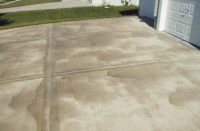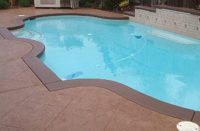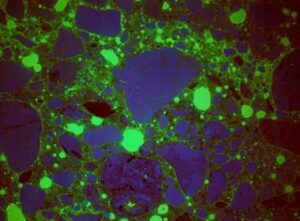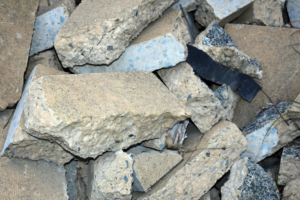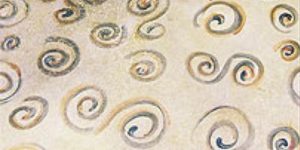
Soybeans are one of the oldest crops in the world, but soy-based products are new to the decorative concrete industry. There are soy-based products available for every phase of a project. Should you be using them?
All soy-based products share some attractive advantages. They are nontoxic and release no harmful fumes or nasty odors. They are biodegradable, so spills don’t require hazmat cleanup. They comply with VOC regulations and sidestep the need for health and safety inspectors on job sites. But what about other practical issues like ease of application, cost, effectiveness and durability?
Here’s a rundown of the types of products available and what it’s like to use them.
|
|
|
|
|
|
Strippers
Imagine smearing a stripping chemical on concrete with your bare hands, leaving it to penetrate the coating you want to remove, returning at your convenience to scrape off the residue, and then simply rinsing the surface clean with plain water. That’s what it’s like to use Soy Gel Paint and Urethane Remover, according to Jason Davenport, marketing director for Franmar Chemical Inc. He says the product can remove polyurethanes, acrylic sealers, and even epoxies.
“If you get this stuff on your skin, it does not burn,” Davenport says. “The only problem some people have is if they’re allergic to soy.”
The soy-based stripper works slower than harsh chemicals such as methylene chloride, but timing is not critical. Soy has an extremely low evaporation rate, is nontoxic, and won’t harm the underlying concrete, so you can leave it unattended as long as you want. Depending on the type and number of layers of coating you’re removing, penetration could take from a few minutes to a couple of hours. “It will go through 25 layers of paint in one application if you give it enough time,” Davenport says.
A couple of things look like disadvantages at first glance. “When people first use it, they think it’s a gooey mess,” Davenport says. “But considering the alternatives of sanding or using something more harsh, it’s a whole lot easier.”
Cost is another potential put-off. At $60 a gallon, Soy Gel looks awfully expensive. But the large coverage rate brings the cost down to around 30 cents per square foot. The product can even be collected and reused, as long as it retains its gel consistency. Furthermore, there’s no need to buy neutralizers or cleaning agents; a surfactant incorporated in the product reacts with plain water to easily rinse the surface clean.
John Bennett, president of Eco Safety Products LLC, points out another advantage. “All of our soy-based strippers are even DfE approved, and those certifications are very difficult to achieve.”
He’s referring to the Environmental Protection Agency’s Design for the Environment program, which promotes products and processes that are cleaner, more cost?effective, and safer for workers and the public.
Mastic Removers
“A lot of mastic removers evaporate, and then the mastic re-adheres to the surface,” Davenport says. “So you have a working time between 1 and 15 minutes to remove it or you’ll have to do it all over again.”
Not so with his company’s Bean-e-doo Mastic Remover. Although it is a liquid, its evaporation rate is so low that it can be applied and left to soak indefinitely. Workers can strip it off whenever they finish with other tasks. Again, cleanup is as easy as rinsing with water.
Like other soy-based products, Bean-e-doo has an extremely high flash point of 600 degrees, making it safer to apply than more volatile products. “A lot of people like to use the soy because they can smoke while they’re using the mastic remover,” Davenport says.
Form Release
Soy Form Release from SoyClean can be sprayed, brushed, or rolled onto forms and molds. Not only is the product an effective release agent that won’t stain the concrete, but soap and water will clean it up. It costs about 9 cents per square foot. “We’ve had customers say the petroleum-based product eats away at certain forms. This one doesn’t,” says SoyClean director of marketing Kurt Brannian.
Stains
Eco Safety Products makes SoyCrete Architectural Soy Concrete Stain, a semitransparent true penetrating stain. “It is a VOC-compliant material with no hazardous components, so it meets all environmental air quality regulations and assists in green building, LEED-certified projects,” Bennett says.
The stain’s semitransparency lets the pigments interact with the porosity and density of the concrete to create a natural mottled look. “You’re always going to get a very rustic look without any artistic talent,” Bennett says. “And people with artistic talent can do just about anything they want with the material. The installer has complete control over the entire stain process.” During about the first four hours after application, the stain can even be washed off with soap and water. After it cures, though, it becomes permanent.
Application involves fewer steps than acid staining, resulting in substantial savings in labor costs. “We have converted acid stain installers that have easily shaved half the labor time in a project,” Bennett says. “And they eliminate all the hazmat issues of disposal of the acid material and the need for respirator gear.”
Sealers
SoyClean’s SoySeal concrete sealer and waterproofer, a penetrating sealer that can be applied with a fan-tip sprayer, doesn’t affect the color of decorative concrete. Over two years of outdoor testing by ASTM standards attest to its durability. “The cost is probably a little bit more, but it’s certainly not prohibitive,” Brannian says. Depending on the application, the cost is between 6 cents and 12 cents per square foot.
Eco Safety’s Acri-Soy penetrating sealers have demonstrated an interesting environmental and performance bonus, according to Bennett. “In high-moisture content areas like coastal communities, the soy seems to deter the growth of mold and mildew,” he says. “We’re hoping to get more scientific data to find out what is it in soy that resists mold and mildew.”
